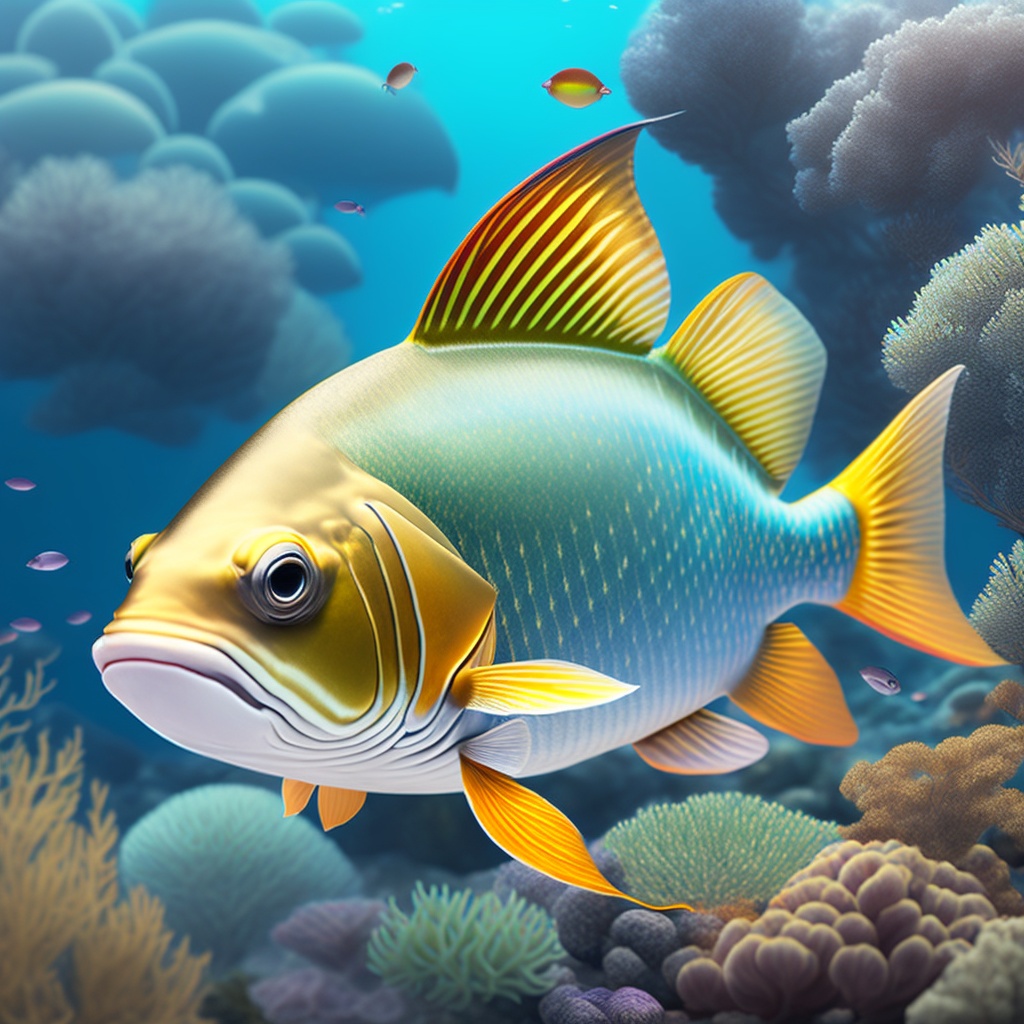Ever looked at your dinner plate and wondered about the journey your fish took before landing there? Not in a Finding Nemo sort of way, of course. More like, has it been a good and healthy journey from an abundant sea or an eco-conscious farm right to your table? Is your plate overflowing with sustainable fish? If these questions have you hooked, you’re in the right place!
Understanding Sustainability in Seafood
Sustainability. It’s a word we often hear in conversation, and it plays a vital role in our daily choices. But when it comes to seafood, what exactly does it mean to be sustainable? Let’s try to unshell this concept.
Sustainability is like a three-legged stool, each leg representing one key aspect: environmental, economic, and social. If any leg is wobbly or missing, the stool won’t stand, just as if any aspect of sustainability is compromised, the whole system is threatened.
Environmental Aspect
Regarding the environment, sustainable seafood must be caught or farmed in a way that does not deplete fish stocks and cause minimal disturbance to aquatic ecosystems. That means preventing practices that damage the seabed, reducing bycatch (that is, unintentional capture of non-target species), and managing fish farms to prevent pollution, disease spread and escapes.
Climate Change and Seafood Sustainability
Climate change brings another layer of complexity to seafood sustainability. Rising ocean temperatures and acidification can disrupt marine habitats and fish populations. Sustainable fishing and aquaculture practices need to account for these changes, adapting to shifts in fish distributions and ensuring operations don’t exacerbate climate impacts.
Economic Aspect
On the economic front, sustainable seafood should provide stable jobs and contribute to a thriving economy. Overfishing, for instance, may seem economically profitable in the short term, but it jeopardizes future earnings when fish stocks collapse. Long-term economic sustainability depends on healthy fish populations that can support fishing communities for generations.
Sustainable Seafood Market
The demand for sustainable seafood is growing worldwide, creating opportunities for fisheries and farms that prioritize sustainability. Businesses can benefit from market-based sustainability programs like eco-certifications, which can attract environmentally conscious consumers and often fetch higher prices.
Social Aspect
The social aspect of sustainability involves supporting the welfare and rights of workers in the seafood industry. That means ensuring fair wages, safe working conditions, and no abuse of forced labor or human rights. It also involves respecting the rights and traditions of Indigenous and local communities who rely on fish for their subsistence and cultural identity.
Community-based Fisheries
Community-based fisheries can play a critical role in social sustainability. By giving communities control over their local fishing grounds, they can manage resources to meet their social, economic, and environmental needs. These fisheries can support local livelihoods, maintain cultural fishing practices, and promote community engagement in conservation.
So, in essence, sustainable seafood is all about balance. It’s about catching and farming fish in a way that supports today’s needs without compromising the ability of future generations to meet their own. It’s not just a buzzword—it’s a philosophy that guides how we interact with our precious oceans. And every time we choose sustainable seafood, we’re casting a vote for this philosophy. It’s a small choice with a big ripple effect. Isn’t that something worth making a splash about?
How Overfishing Affects Our Ecosystem
To help visualize, let’s think of a game of Jenga. In the game, every block pulled affects the balance of the whole tower, just as in the ecosystem; every species plays a role in maintaining the balance. When we overfish, it’s like pulling out a Jenga block. Too many blocks and the tower collapses. Except in this case, the ‘tower’ is our precious marine life.
Identifying Sustainable Fish
In the world of sustainable seafood, we need to be detectives, foodies, and conservationists all at once. But don’t worry; you don’t need a magnifying glass or a marine biology degree to identify sustainable fish. It’s all about knowing what to look for and asking the right questions.
Trusted Labels and Certifications
Eco-labels and certifications can be your first line of defense in identifying sustainable fish. These are like badges of honor given to fisheries and farms that meet certain sustainability standards.
Marine Stewardship Council (MSC)
The Marine Stewardship Council (MSC) is one of the most well-known certification bodies. They certify wild-caught fisheries that meet their science-based standards for sustainable fishing. So, when you see that blue MSC label, you know that the fish was caught in a way that maintains healthy fish populations and minimizes environmental impacts.
Aquaculture Stewardship Council (ASC)
For farmed fish, the Aquaculture Stewardship Council (ASC) is a reliable certification to look for. They set standards for responsible aquaculture that address both environmental and social impacts. Farms certified by ASC must demonstrate responsible practices such as minimizing pollution, conserving water and biodiversity, and respecting workers’ rights.
Questions to Ask Your Fishmonger
While certifications can be a helpful guide, they’re not the only way to identify sustainable fish. Don’t be shy about asking questions when shopping at a fish market or dining at a restaurant.
Where is this fish from?
Knowing where your fish comes from can tell you much about its sustainability. For example, Alaskan salmon and Pacific halibut are known for their strong management and healthy populations. However, certain areas may be overfished or lack proper regulations, which can pose sustainability concerns.
How was this fish caught or farmed?
The fishing or farming method can also impact sustainability. Some fishing methods, like pole-and-line or troll, are selective and have low bycatch, making them more sustainable. On the other hand, techniques like bottom trawling can cause significant habitat damage. For farmed fish, practices like integrated multi-trophic aquaculture (where different species are farmed together to recycle nutrients) can be more sustainable.
Is this fish in season?
Just like fruits and vegetables, fish have seasons too. Fishing during spawning seasons, for instance, can impact fish populations. So, asking about seasonal availability can give you an idea about the sustainability of your fish.
Online Resources
Online resources can be handy tools for identifying sustainable fish. Websites and apps like Seafood Watch by the Monterey Bay Aquarium provide up-to-date recommendations on which fish are the best choices in terms of sustainability. They even have regional guides to help you make informed choices based on where you live.
Identifying sustainable fish may seem challenging, but with these tips, it’s easier than finding a clownfish in the Great Barrier Reef. Plus, it’s an opportunity to learn more about our food and our oceans. And who knows, your curiosity might just spark a wave of change. After all, every great wave starts with a single ripple, right?
Sustainable Fish Varieties You Should Know
As a seafood lover, you’ve probably wondered if your favorite fish is a sustainable choice. Well, worry not! Here’s the lowdown on some popular fish species also making sustainability waves.
Pacific Halibut
Pacific Halibut are like diligent students who always abide by the rules. They’re large flatfish native to the North Pacific Ocean and are carefully managed to maintain their population levels.
Why is Pacific Halibut sustainable?
Well, Pacific Halibut fisheries are known for their strong management. They use a catch share system, where a total allowable catch is divided among fishers. This approach reduces pressure to catch fish quickly and allows fishers to focus on quality over quantity. Also, the gear used to catch Pacific Halibut – longlines – has relatively low bycatch and minimal habitat impact. Plus, let’s not forget they’re absolutely delicious, making them a great sustainable choice for your next seafood feast.
Alaskan Salmon
Alaskan Salmon is like the class president of sustainable fish. They’re wild, they’re nutritious, and they’re all about sustainability.
Why is Alaskan Salmon sustainable?
Alaska is known for its rigorous fishery management that focuses on long-term sustainability. The Alaskan Salmon fishery follows a principle of “sustained yield”, where fishing is limited to ensure salmon populations remain healthy over time. Plus, the fishing methods used, such as seining and gillnetting, are designed to target specific species and sizes to minimize bycatch. As a bonus, Alaskan Salmon is rich in omega-3 fatty acids, making it a tasty and healthy choice.
Arctic Char
Arctic Char might not be the most popular fish at the fish counter, but they’re a real catch when it comes to sustainability.
Why is Arctic Char sustainable?
Arctic Char available in the market are usually farmed, and guess what? They’re a shining example of sustainable aquaculture. These fish are often farmed in land-based, closed systems that have less environmental impact than open-net farms. These systems prevent fish escape, reduce the spread of disease, and manage waste effectively. So, choosing Arctic Char not only adds variety to your plate but also supports innovative farming practices that are good for our planet.
Remember, sustainability can vary across regions and even individual fisheries or farms. So while these fish species are often sustainable choices, it’s always a good idea to check the latest information from trusted resources or ask your fishmonger.
In the world of sustainable fish, it’s not just about picking the tastiest option but also about making choices that help our oceans thrive. Now, doesn’t that make your seafood dinner a bit more special? After all, good food tastes even better when it’s good for the planet too. Don’t you agree?
Promoting Sustainability
Promoting sustainability in seafood isn’t about pointing fingers but extending hands. It’s about recognizing our collective responsibility and capacity to make a difference. Here’s how you can help steer the ship toward sustainable fisheries and aquaculture.
Advocating for Sustainable Fishing Practices
When it comes to promoting sustainability, your voice matters. It’s like casting a line – you never know what you might reel in.
Influence Your Supermarket
Start by asking your local supermarket to stock more sustainably-sourced fish if they don’t already. Supermarkets are sensitive to customer demand. So, don’t underestimate the power of a simple request. It could be the push needed to get more sustainable fish on the shelves.
Make Informed Choices at Restaurants
At restaurants, feel free to ask the chef or server about the source of their seafood. If more diners request sustainable options, restaurants will be motivated to include them on their menus.
Small Actions, Big Impacts
Promoting sustainability isn’t just about grand gestures. Sometimes, it’s the smallest actions that can create the biggest ripples.
Share Sustainable Recipes
Got a killer recipe for Grilled Alaskan Salmon or Pacific Halibut tacos? Share it with your friends and family or even on social media. By doing so, you’re not just sharing a delicious meal idea but also spreading the word about sustainable seafood.
Educate and Inspire
Talk about sustainable fish at your dinner table, in your social circles, or in your community. Share what you’ve learned, inspire curiosity, and encourage others to make more sustainable choices. Remember, change often starts with a conversation.
Support Policy and Research
Sustainability also needs strong policy and science. By supporting laws that protect our oceans or by contributing to organizations that conduct research on sustainable fishing and aquaculture, we can help create a more sustainable future for our seafood.
Vote with Your Wallet
Every time you buy sustainable seafood, you send a clear message to producers, retailers, and policymakers about what matters to you. It’s a way of voting with your wallet for the kind of world you want to live in.
Promoting sustainability in seafood might seem like a big task, but it’s really a journey of a thousand small steps. And each step you take, no matter how small, brings us closer to a healthier, more sustainable relationship with our oceans. So, are you ready to take that step? Because the journey starts now. And it starts with you.
Conclusion
There you have it – a deep dive into sustainable fish. It may seem like a drop in the ocean, but remember, every drop counts. And when it comes to making eco-friendly choices, sustainability is attainable and deliciously rewarding!
FAQs
What is sustainable fish?
Sustainable fish are those caught or farmed in a way that ensures the long-term survival and health of the species and its ecosystem.
Why is sustainable fishing important?
Sustainable fishing is vital for maintaining healthy fish populations and protecting the marine environment, ensuring we have fish for the future.
How can I identify sustainable fish?
Look for eco-labels such as MSC or ASC when shopping. At a fish market, don’t be afraid to ask about the fish’s origins and how it was caught.
What are some types of sustainable fish?
Some popular sustainable fish include Pacific Halibut, Alaskan Salmon, and Arctic Char. However, it’s best to check updated resources as the status can change.
How can I contribute to promoting sustainable fishing?
By choosing sustainable fish, asking suppliers about sustainability, sharing sustainable recipes, and spreading awareness, you can contribute to the cause. Remember, every action counts!





Pingback: Three Pillars of Sustainability: A Guide to a Better Future
Pingback: Why is Recycling Important? A Definitive Guide - Eco Life Wise
Pingback: Eco Friendly Companies: Meet the Eco Super Heroes
Pingback: Why Recycle? Your Ultimate Guide to the Big Green Reason
Pingback: Solar 5e: Harnessing the Sun's Energy Like Never Before
Pingback: Navigating the World of Sustainable Clothing Brands
Pingback: Self Sustaining Homes: A Definitive Guide to the Exciting Future
Pingback: Pros and Cons of Solar Energy: Weighing it Up | Eco Life Wise
Pingback: Sustainable Palm Oil: Championing a Greener Planet
Pingback: What is Coral Bleaching? A Fascinating Dive Underwater | Eco Life Wise
Pingback: Why Is Biodiversity Important? Earth's Ecological Wealth | Eco Life Wise
Pingback: Off Grid Solar System: A Step Toward Self Sufficiency
Pingback: Solar Farms: Harnessing the Power of the Sun | Eco Life Wise
Pingback: Sustainable Lingerie: An Eco Friendly Revolution in Your Drawer | Eco Life Wise
Pingback: Sustainable Swimwear: A Deep Dive Into Eco Friendly Choices
Pingback: Sustainable Fashion Brands: Redesigning Style Responsibly
Pingback: Sustainable Fabrics: Charting the Course for Eco-Friendly Fashion
Pingback: Benefits of Recycling: Maximizing Your Impact for a Greener Planet
Pingback: Net Zero Revolution: North Carolina Leading the Way | Eco Life Wise
Pingback: How Does Meat Consumption Impact The Environment? 7 Powerful Ways | Eco Life Wise
Pingback: What Are The Advantages Of Compostable Packaging? | Eco Life Wise
Pingback: Why Should We Reduce Single-use Plastics? | Eco Life Wise